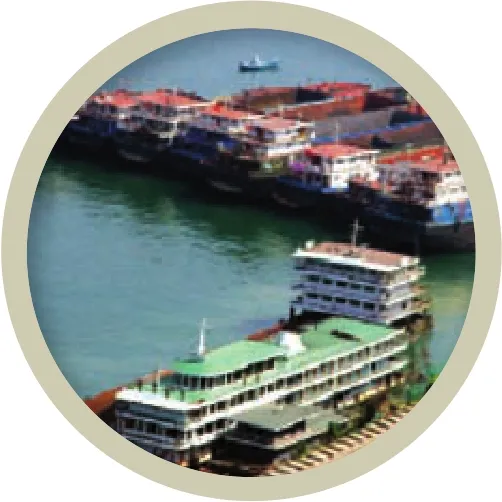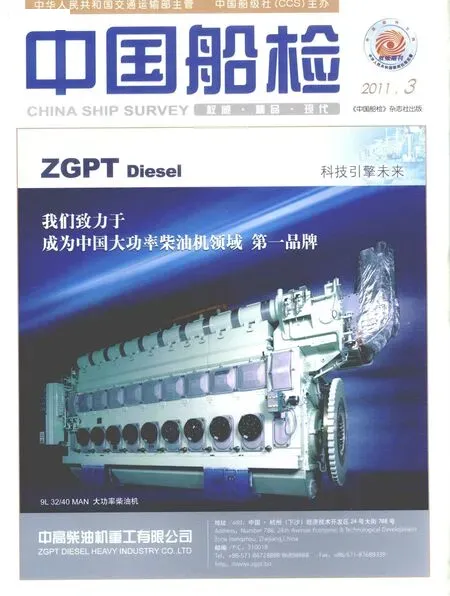内河水运,当幸福来敲门
本刊记者 徐 华
内河水运,当幸福来敲门
本刊记者 徐 华
● 水利投资盛宴,内河航运受益几何?
● 《航道法》,千呼万唤却为何始终像雾像雨又像风?
● 管理体制,要纠结还是要畅通?

2010年1月29日,新世纪以来中央指导“三农”工作的第八个中央一号文件发布,明确将大力加强水利建设,多渠道筹集资金,力争今后10年全社会水利年平均投入比2010年高出一倍,未来10年4万亿水利投资将成经济新引擎。1月30日,《国务院关于加快长江等内河水运发展的意见》出台,提出要利用10年左右的时间,建成畅通、高效、平安、绿色的现代化内河水运体系,到2020年,全国内河水运货运量达到30亿吨以上。
新出台的两个文件,在战略层面上明确了国家的政策导向,会在一定程度上对内河水运发展带来积极的影响,未来还将会有更多的政策优惠,把目光和货物引到水运上来。目前,国家西部开发政策,以及西部地区劳动力、土地成本相对较低,资源充沛等优势,吸引了许多产业的西迁,比如钢厂,大型的制造业,未来,这些企业的产品运输对于水运的依存度将会越来越大,同时也会带动内河的发展。
那么,要将内河发展确实放在战略的角度来看,就要关注和正视其目前所面临的问题。首先,还是投资问题。多年来,内河的欠账太多,发展始终步履维艰。航道维护不足,碍航设施繁多,使航道等级降低,航运能力萎缩,甚至消亡。航道建设区别于公路、铁路等交通设施,在于它投资回报的周期长,很难马上看到效果,这一来使资金的筹集面临巨大困难,另外,由于航道是公益性基础设施,且无法像公路一样建立起“贷款建设、收费还贷”的筹资发展机制,导致筹资渠道过于狭窄、建设资金严重不足。况且,从公路与高铁的贷款发展模式来看,依然存在着很大的矛盾,为了偿还贷款,造成过路费用过高,从而使物流企业成本过高,产生了很多衍生的社会问题,同样,高铁的迅速发展,借助于贷款得以实现,然而,高铁运营却受到还贷的压力,以北京至天津线为例,一年就亏损几个亿。所以,内河正处在发展的起步时期,投资也会随之而来,那么,选择怎样的投资模式,如何有效地利用这些投资依然需要思考。从国外的成功经验来看,内河作为国家的公益事业,投资主要由国家来承担,美国密西西比河发展建设,主要都是政府投入。
国家提出综合运输体系的全面发展,那么对这一体系的管理要在机制体制上就要从综合与统一方面着手。而目前,各自为政的条块式管理依然固我存在,只注重单一的运输模式的规划,并不能将各种交通方式有效的衔接,形成综合交通运输网络。国家应该有一个统领部门将各种运输部门统一管理,统一制定规划。

苏国萃全国政协委员,交通运输部水运科学研究院副总工程师、研究员。曾获“国家有突出贡献中青年专家”称号。

金义华全国政协委员,原任长江航道局党委书记,交通运输部长江航务管理局党委书记、局长。
水运在发展低碳经济、低碳运输中具有运量大、成本低、投资省、单位能耗低、环保等优越性。然而,时至今日,《航道法》仍然没有出台,对航道资源保护、养护资金及管理等方面缺乏法律支持保障,影响了航道建设养护成果的巩固和水运事业的可持续发展。
现行航道法规层次不高,不能很好地协调水资源综合开发利用中的各种关系。在水资源的开发中,一些地方在进行防洪、筑坝、水电、建闸等水工工程时,各自为政。此外,在航道上建设桥梁、管道、架设电线等跨河、临河建筑物,有的没给水运发展预留空间,也限制了船舶航行,有的甚至造成航道中断。尤其是2002年修改后的《水法》,将航道资源保护的一些内容删除,这样在水资源综合开发利用发生矛盾时,就不能很好地协调水运与防洪、发电等各方面的关系。现有航道法规不能很好地适应形势发展的需要。随着我国社会经济的发展,现有航道法规内容已明显不适应社会发展的要求。另外,作为水路运输的四大要素之一的航道,其开发、建设资金的投入也需要法律法规的支撑。航道部门的执法缺乏依据,不能有效保护和管理航道资源。近年来,国家在保证审批制度改革和清理违法行政处罚工作中,交通部门对拦河、临河、跨(过)河建筑物的审批及对采挖河砂的审批常常受到法律依据方面的质疑。另外对海损中的存留在航道中沉船,航道基础设施被损等,由于没有专门的《航道法》设定相应的行政处罚措施,航道部门的执法缺乏依据,不能有效保护和管理航道资源。
为此,加快出台《航道法》,对航道的规划、建设和养护的资金、航道的保护及管理提高到国家法律层面,以更好地适应社会经济发展对水运的要求。
一直以来,三峡枢纽工程通航建筑物及配套设施在工程建设期采取的是业主负责的管理体制,通航建筑物由业主委托给交通部门管理,其运行维护管理经费由三峡总公司提供,在三峡电站电力成本中列支。十多年的运行实践证明,交通运输部门实行的这种高度集中的综合管理模式较好地适应了三峡和葛洲坝两坝特殊江段的管理,有力促进了长江航运生产力发展,消除了重大安全隐患,保证了三峡工程建设。但从长远来看,委托管理方式造成管理体制不顺、职责不清,不利于永久通航的管理。
为此,建议完善三峡枢纽工程通航建筑物运行管理主体和事权范围。将三峡通航建筑物纳入长江航运一体化管理,明确交通运输部所属的长江三峡通航管理局对三峡枢纽工程通航建筑物的管理主体地位,负责三峡通航建筑物的运行与维护管理。三峡枢纽工程通航建筑物管理经费由国家财政安排。
同时,建立三峡和葛洲坝枢纽管理国家级协调机制。为保证实现三峡和葛洲坝工程防洪、发电、航运三大效益的发挥和长江航运一体化的系统管理,建议组建国家级协调机构,防洪、电力、交通运输等部门参与,负责协调通航建筑物运行过程中防洪、发电、航运等方面的相关工作。
On Jan 29th, 2011, the eighth central government No.1 document guiding the work of “agriculture,countryside and farmer ” since the new century was issued. It clearly states that hydraulic construction should be vigorously strengthened and that funds should be raised through various channels to ensure that the average annual investment in hydraulic construction double that in 2010 for the next 10 years. The four trillion investment in hydraulic construction in the next ten years will be the new engine of economic development. On Jan. 30th, the “State Council comments on accelerating the development of the waterborne transportation in the Yangtze River and other inland waterways ”was issued,putting forward the construction of unblocked, efficient,safe and green modern river transportation system in the next ten years, and the volume of goods transported in the national inland waterways be over 3 billion tons by 2020.The development of inland waterborne transportation should be seen from the strategic perspective and the current problems should be paid attention to and be faced squarely. First, it is the problem of investment.Construction of shipping lanes is different from that of road, railway and other transportation facilities in that its cycle of investment return is long, and there is no immediate effect, which makes the raise of funds difficult. Besides, shipping channel is the fundamental facility for the public good and the fund-raising system

Su Guocui, the member of the national committee of CPPCC points out that the two documents newly issued defines the national policy orientation on the strategic level, and will to some degree have a positive inf l uence to the development of inland waterborne transportation.There will be more preferential policies in the future and attention and cargo will be allured to the waterborne transportation.of “construction on loan, paying off through fares” for road construction cannot be established for the shipping channels, this makes the channels to raise funds for shipping channel construction very few and the funds for construction very insuff i cient. Moreover, judging from the development modes of loan for road and railway, there still exist big conf l icts. In order to pay off the loan, tolls have been set too high, this leads to the high cost for logistics enterprises which in turn causes many social problems.Similarly, the fast development of high-speed railways is realized by way of loans. However, the operation of highspeed railways has the pressure of paying off loans. Take the railway from Beijing to Tianjin as an example, a loss of RMB 8 billion is recorded for a single year. Therefore,inland waterway is in the initial development period, and the investment will come later on. Which investment mode should be chosen and how to use effectively these investments are questions which merit consideration.Judging from the successful experience abroad, as the national public welfare establishments, investment should be provided by the government. The US government has provided the main investment in the 300-year-old Mississippi River.
The committee member, Jin Yihua thinks that for the development of low carbon economy and transportation,waterborne transport has the advantages of large transportation volume, low cost, less investment, low energy consumption and environmental protection.However, up to now, “Law of Navigation Channels”has not yet been introduced, this makes the protection of channel resources, maintenance of funds and management be in the need of the legal support and guarantee, which affects the strengthening of the achievements of channel construction and maintenance and the sustainable development of waterborne transportation industry.
The current laws and regulations for navigational channels are of low level and can not coordinate well the various relations in the comprehensive development and utilization of water resources. In some places, for the development of water resource, the authorities act separately and independently in the course of the projects such as flood control, dams construction,hydropower, sluices construction and other hydraulic works. In addition,when setting up buildings near or across the river, such as bridges,pipe lines and electric lines, sometimes no space is reserved for the development of waterborne transportation which limits the navigation of ships and even blocks the channel. Particularly, the “Law of Water ” as amended in 2002 deleted some contents of the protection of channel resources, which has made it impossible to coordinate the relations between waterborne transportation and flood control and hydraulic power generation when conf l icts arise in the course of comprehensive exploitation of water resources. The current laws and regulations for navigational channel can not adapt to the needs of the development of the situation.
With the development of China’s social economy, the current laws and regulations for navigational channels obviously do not correspond to the demand of social development. In addition, as one of the four elements of waterborne transportation, navigational channels should have the support of laws and regulations for its development and investment of construction funds. Lack of laws for the enforcement by the authorities will make it impossible to effectively protect and manage channel resource. In recent years, in the course of the work of reforming review and approval system and clearing illegal administrative penalties,authorities responsible for transportation have always been questioned in terms of legal grounds for their review and approval of buildings set up near or across the river or their review and approval of river sand exploitation. In addition, as regards the wreck remaining in the channel and channel infrastructure damage, the lack of a specif i c administrative penalty in the “Law of Navigational Channel” has left the authorities with no legal grounds and the channel resource cannot be effectively protected and managed.
Therefore, the introduction of a "Law of Navigational Channel"should be accelerated. The plans of channels, fund for construction and maintenance, protection and management of channels should be promoted to the national law level in order to better adapt to the waterborne transportation required for the social economic development.
Inland Waterway Transportation,Pursuit of Happiness
Reporter Xu Hua

